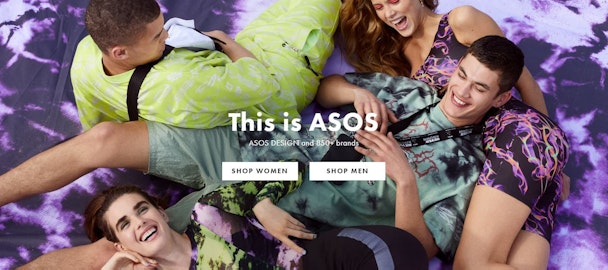What's next for Asos as it culls jobs and rethinks marketing?
Online retailer Asos is to cut 100 jobs after suffering an 87% drop in pre-tax profits earlier this year due to a slew of factors including industry discounting, a slump in sales, website issues and a persistent core problem with "serial returners".

Asos job cuts ahead after profit warning
As the e-commerce giant approaches its 20th year in business it is facing fundamental difficulties with its model. The Sunday Times reported that as a result of these pressures some 100 jobs at its London headquarters in Camden will be cut. A significant, but unverified, number of these are to hit the marketing department.
Asos was working sporadically with ad agencies like Uncommon to develop new brands and it is investing heavily in voice tech and AI to convert browsers to buyers.
Asos declined to comment on the planned cuts or the impending impact on its marketing plans when approached by The Drum.
It has been experimenting with its marketing spend over the last few years to find the best mix to fit with its global digital presence. In 2018, it marginally reduced its marketing budget but lauded the effects of Instagram Stories where it saw views on the platform double in just six months. As a percentage of sales, marketing spend stood at 5%.
Then, in the face of a profit warning in December 2018, Asos chief executive Nick Beighton announced that it would U-turn on the marketing reduction and enter 2019 with a "stronger" spend.
By April 2018, pre-tax profits fell 87% to £4m year-on-year. Asos blamed a drop in the visibility of its website reducing traffic. There was also a "significant deterioration” in sales in the run-up to Christmas as well as an uptick in the volume of returns and refunds it was handling.
Rob Sellers, managing director of shopper agency GreyBase, said Asos' troubles are the same as those faced by many online retailers as they try to continuously elevate the customer experience to stay ahead of the start-ups and simply keep up with more established players.
"Innovations come from all types of retailers, particularly the likes of Amazon, with the ability to shrink delivery times, deliver to the boot of your car, and enter your house. You have to give the shopper a sense that buying online is a seamless and convenient thing to do," he said.
"Asos was an early winner in fashion commerce, but being a trailblazer, and getting so large so quickly, means it is struggling to augment its business model, which in itself is now being disrupted. Businesses have popped up specifically around the buy/return/keep behaviour. Stitch Fix lets you subscribe to fashion supply, Warby Parker lets you try glasses styles for a time at home before you make a final decision, and financial services like Klarna helps you manage the cash flow of this type of behaviour, so you’re never out of pocket."
Asos won't stop so-called 'serial returners’ "doing what seems like a sensible and modern way to shop" with an exclusively digital company – so it will need to solve it "by looking inwardly about the way it can satisfy this now established consumer demand".
Anusha Couttigane, principal fashion analyst at Kantar said that cost savings could derive from restructuring roles and investing into services and tools that enable shoppers to make better-informed decisions, like 360 video imagery, multi-model product displays and broader size information.
This is something Amazon is doing with the Echo Look (below) which can visualise clothes on consumers. It is among many AR experiences coming to market.
Acknowledging the issue, last month Asos launched an AR feature that lets customers try on select goods. The Virtual Catwalk was designed with London-based augmented reality firm, HoloMe. T
his has been integrated with its app that has been downloaded 10 million times. Visitors use the app an average of almost seven times a month - with 9.5 minutes of dwell each time.
It's been innovating recently with the rollout of its first-ever chatbot, dubbed Enki, and a voice shopping tool on Google Home look to increase its visibility but it has to refine the core business model.
"There is a growing trend towards using technology to create a more accurate impression of the appearance of apparel items. However, we are not there yet," said Couttigane.
While Asos critiques serial returners, Couttigane said that they may not be so much abusing the system, rather they are the new status quo that Asos would be wise to cater to.
"Asos is also competing against the likes of Prime Wardrobe, consumers are coming to expect this level of service, whereby they have the opportunity to try things on at home, at their own convenience, and return unwanted lines at the inconvenience of the retailer," she said.
"Asos does offer a limited rental service but one could argue that, in the age of the circular economy, when demand for sustainable fashion is going up and consumers are beginning to prioritise access over ownership, responding to this trend in a more agile way by ramping up rental services could help Asos recoup some of that revenue attrition."

